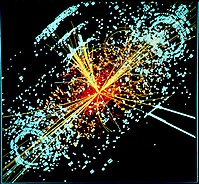
Photo from wikipedia
A bstractThe detection of coherent neutrino-nucleus scattering by the COHERENT collaboration has set on quantitative grounds the existence of an irreducible neutrino background in direct detection searches of Weakly Interacting… Click to show full abstract
A bstractThe detection of coherent neutrino-nucleus scattering by the COHERENT collaboration has set on quantitative grounds the existence of an irreducible neutrino background in direct detection searches of Weakly Interacting Massive Dark Matter candidates. This background leads to an ultimate discovery limit for these experiments: a minimum Dark Matter interaction cross section below which events produced by the coherent neutrino scattering will mimic the Dark Matter signal, the so-called neutrino floor. In this work we study the modification of such neutrino floor induced by non-standard neutrino interactions within their presently allowed values by the global analysis of oscillation and COHERENT data. By using the full likelihood information of such global analysis we consistently account for the correlated effects of non-standard neutrino interactions both in the neutrino propagation in matter and in its interaction in the detector. We quantify their impact on the neutrino floor for five future experiments: DARWIN (Xe), ARGO (Ar), Super-CDMS HV (Ge and Si) and CRESST phase III (CaWO4). Quantitatively, we find that non-standard neutrino interactions allowed at the 3σ level can result in an increase of the neutrino floor of up to a factor ∼ 5 with respect to the Standard Model expectations and impact the expected sensitivities of the ARGO, CRESST phase III and DARWIN experiments.
Journal Title: Journal of High Energy Physics
Year Published: 2018
Link to full text (if available)
Share on Social Media: Sign Up to like & get
recommendations!